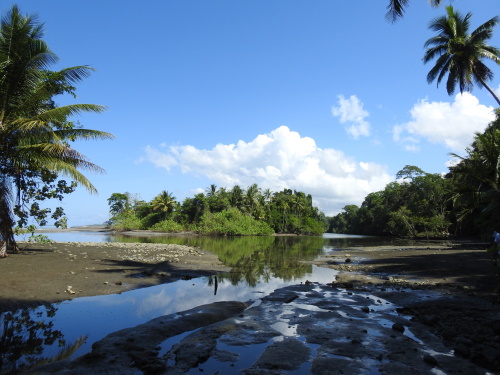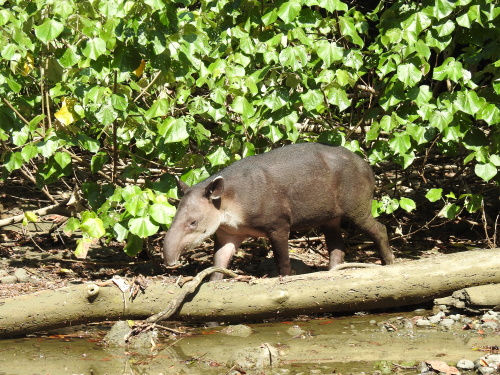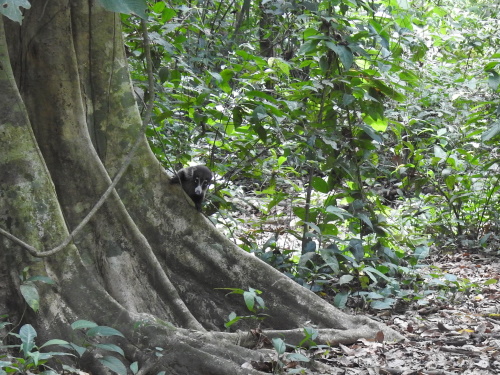Blog TWHS Visits
Corcovado NP
Corcovado currently is the only entry on the Tentative List of Costa Rica. There seem to be no plans to bring it forward (again), after the 2004 withdrawal caused by a negative IUCN advice. At the time it was dismissed with not much further explanation than “too small”, too small even for its mammals to survive in the near future. It could not match similar sites (Darien, Talamanca) that were already inscribed. Although I can see the point, I still found it the most worthwhile destination of my Costa Rica trip.
I based myself for 3 nights in Drake Bay, the most common access point on the Osa Peninsula. It is off the beaten tourist track, but not that remote. The area around Drake Bay itself is already really nice, I did a late afternoon birding tour there and hiked part of the Drake Bay Trail (a 20km long coastal path) on my own. I could have easily stayed one or two nights longer, tying in a trip to Isla del Cano for example.
For my Corcovado visit I booked a day tour to the Sirena station of the National Park at the cost of 85 USD. You may only visit the park accompanied by an official guide. At 6 a.m. two boats with some 25 tourists each set from the coast of Drake Bay, already a minor adventure in itself as the place has no jetty. So you have to wade from and to the boats. I shared a guide with a couple from Alaska and a guy from Spain, so it was a pleasantly small group. We hardly met the other groups while in the park, we only did so at the centrally located ranger station which has a small shop, a place to refill your waterbottle and toilets.
After an hour’s boat ride we landed at low tide at Corcovado. There is a very large tidal difference and we had to walk 200 meters over pebbles and the remains of molten lava to get on shore. We had to report to the ranger post first. What now is the park used to be inhabited and it was agricultural land. It only became a protected area in 1975.
Corcovado is best known for the presence of a large number of mammal species that are easy to spot. In the bushes right next to the beach we quickly discovered a small deer, a Red brocket. We left the beach for the forest at the mouth of a river, an idyllic spot. This is were the guide found us the flagship species of Corcovado: the Bairds tapir. These animals are most active early in the morning, now around 8 o'clock they were resting. We found two: a mother with a 6 months old calf. They were in the undergrowth and we tried to find an angle to take good pictures without disturbing them.
That effort proved to be unnecessary in the end, as after a few minutes they started walking out into the open on their own. They ate some leaves, peed in the river and then disappeared from sight. Although we were only 5 meters away, they went about their business undisturbed. While we were waiting for the tapirs to move, one of the tour mates suddenly spotted another creature walking over a tree trunk. I immediately recognized it as a tayra, a marten-like species. The guide was also completely perplexed that we saw it in broad daylight. These were certainly the 15 best mammalwatching minutes of this trip!
We spent 4.5 hours in Corcovado and walked a couple of the trails around Sirena. Monkeys are easily seen here, but I had already covered all four Costa Rican species without much effort in the days before. Only the Geoffroy's spider monkey can be observed here better than elsewhere. We found a group relaxing on the tree branches. Furthermore we saw three more tapirs resting in a mud bath, an agouti, mantled howler monkeys, Central American squirrel monkeys and some birds including a spectacular woodpecker. And a group of white-nosed coatis ran down the path. Our efforts to spot a sloth were unsuccesful. We did see a boa constrictor though, sleeping in a tree. It did not show its head, but its fat body alone already was impressive.
So mammalwise it was a succesful tour. It may be because of the park’s relatively small size and island-like biological isolation that the animals can’t move away from the park trails and are accustomed to the presence of people.
Els - 11 April 2021
Comments
Esteban Cervantes Jiménez (vantcj1) 12 April 2021
Loved this comment. Yes, it is pretty much a place where you see a lot of wildlife easily (of course with the valuable help from a guide), which is not the most usual thing in a wet tropical forest. I had as much luck as you when I went there (to both Sirena and San Pedrillo sectors) in late 2016.
Regarding a WH nomination, as you indicated, it seems totally dead at this point. IUCN's review was ultra harsh on this site (I don't say it for being a Costa Rican, I say it because I have elements to compare to other natural sites, even inscribed) and the government simply chose not to follow thru.
The day you did the hike from Bahía Drake along the coastline, you discussed how much you saw -outside the NP- also a lot of the species that you saw in the park. To me, it is a point to go from this TL to a new one that incorporates the Piedras Blancas NP, the Golfo Dulce FR, the Pejeperro and Pejeperrito wetlands and parts of the Térraba-Sierpe National wetland, maybe Caño island and marine areas, as a probable nomination of most or the whole Osa Conservation Area, which I think might be much stronger, for its ecological continuity and very high biodiversity.
That would have complications according to Costa Rican legislation (Forest Reserves and the Térraba-Sierpe wetland are mostly on private soil, though very preserved, the rest of areas are public and wouldn't pose a problem).
After traveling around the country for decades, I have some ideas of sites that may have OUV, but a Osa Conservation Area nomination is for me a strong contender.
Els Slots 12 April 2021
At 42,500 ha it would be much larger that the smallest natural WHS in our connection . So "small" is not really a good reason.
Jay T 12 April 2021
That’s good background on where Costa Rica is with its tentative list. There are some other natural sites that are pretty small — I wonder what IUCN would have considered appropriate for Corcovado and its surrounding environs. I’m glad you had such success finding animals on your tour!


